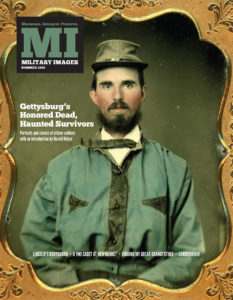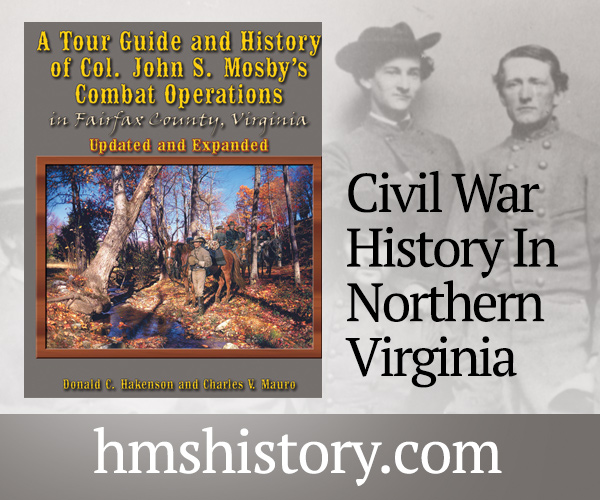 The complete issue
The complete issue
Vol. XXXIV, No. 3
(72 pages)
Print edition: Visit our store to check availability
Digital edition: Visit JSTOR.org to purchase
Subscribe to MI
Explore the MI Archives: Browse | Advanced search | Tutorial
Inside
Cover image
An original color-tinted sixth-plate ruby ambrotype of Lt. John R. Emerson, who served in Company E of the 26th North Carolina, from the collection of Charles Joyce. His story appears on pages 36-38.
Download (free)
Table of Contents (p. 1)
Download (free)
Editor’s Desk (p. 2)
The editor reflects on the enduring legacy of the Battle of Gettysburg. He introduces the cover story, a gallery of portraits of Union and Confederate soldiers who were killed, wounded or captured during the three-day engagement.
Download (free)
Mail Call (p. 3)
Feedback includes an anecdote about 6,000 Dead Letter Office ambrotypes, praise for Richard A. Wolfe’s “Custer’s West Virginia Red Ties,” the identification of a Massachusetts soldier pictured in the Spring 2016 issue, and thoughts about the Jefferson and Varina Davis tintypes, truth and understanding.
Download (free)
Passing in Review (p. 4)
Distinctive Union soldier portraits are the stars of the show in a self-published book of highlights of one man’s 30-year journey as a Civil War photo collector. In The Union Soldier: Images of the Civil War, Bruce Bonfield brings together 170 selected photographs from his personal holdings.
Download (free)
The Honored Few (p. 5)
At the Battle of Gettysburg, Col. Wheelock Graves Veazey of the 16th Vermont Infantry led a bold counterattack against advancing Confederate troops during Pickett’s Charge. The Vermonters was successful. In 1891, Veazey was recognized with the Medal of Honor for his courage on the battlefield.
Photo Sleuth by Kurt Luther (pp. 7-8)
What is the value of a photo inscription as an identification tool? Author Kurt Luther shares how the post-war writing taped to the back of a tintype helped solve one photo mystery—and introduce another.
Finding My Great-Grandfather by Mark H. Dunkelman (pp. 9-10)
It’s the dream of Civil War students with an ancestor who fought for the Blue or Gray—finding an original wartime portrait of their soldier. And when it happened to Mark Dunkelman, whose great-grandfather fought with the 154th New York Infantry, it was one of the most fantastic finds he had ever had in six decades of researching the regiment.
Cardomania! How the Carte de Visite Became the Facebook of the 1860s by Ronald S. Coddington (pp. 12-17)
The carte de visite format is a blip on the timeline of photographic history, wedged between the beauty of the daguerreotype and the technical improvements later in the 19th century. But during its heyday in the 1860s, cartes de visite affordability, reproducibility and share-ability made it a social media powerhouse.
Jefferson Davis, Political Soldier by John O’Brien (pp. 18-19)
In early 1861, Jefferson Davis served as major general in command of Mississippi’s army. The stint lasted only a few weeks until he was inaugurated president of the Confederate nation. During this brief period, curious Northerners wanted to see a portrait of Davis in uniform. New York photographer Charles Fredricks made it happen with a bit of photo trickery.
Antebellum Warriors (p.20)
A daguerreotype of a pre-Civil War militiaman wearing chevrons and epaulettes on his uniform seems confusing. Is he a commissioned or non-commissioned officer? The answer may be a surprise.
Honored Dead, Haunted Survivors introduced by Harold Holzer (pp. 21-35)
They fell in the thousands during three brutal days of carnage in a crossroads community in southeast Pennsylvania. The ground hallowed by their blood—Little Round Top and Culp’s Hill and The Wheatfield—are forever part of our American memory. A small yet significant group of the men who were killed, wounded or captured are remembered here in portraits and personal stories.
Final Harvest: The Last Journey of a Confederate Lieutenant Wounded and Captured at Pickett’s Charge by Charles Joyce (pp. 36-38)
Lt. John R. Emerson and his comrades in the 26th North Carolina Infantry marched into the hail of fire at Pickett’s Charge and like so many of the regiments were decimated in the assault. For Emerson and so many others who were shot and captured by the enemy, the day marked the beginning of a journey from which many never returned.
A Gallant Son of Orange Falls at Gettysburg by Ronald S. Coddington (pp. 40-43)
The body of Capt. Isaac Nicoll of the 124th New York Infantry was lined up with other dead after Georgia Confederates took position of part of Houck’s Ridge on the afternoon of July 2. One of the Georgians picked a Bible out of Nicoll’s pocket. The Testament’s journey from its late owner to his father in New York is the stuff of legend.
Return and Retreat at Gettysburg: A Seminarian Is Called to Arms to Defend His College Town by Paul Russinoff (pp. 44-46)
Frederick Klinefelter, like many college students during the war, suspended their studies to enlist in the army. Klinefelter’s circumstances are however unusual, for he had attended Gettysburg College and was a student at the Lutheran Theological Seminary when Gen. Robert E. Lee and his Confederates invaded the North. The young seminarian joined many of his fellow students to repel the invaders, and went down in history as among the first to fight at Gettysburg.
Immortality on Little Round Top, Butchery in Saunders Field by Kevin Canberg (pp. 48-50)
Two officers who served in the 140th New York Infantry, Capt. Henry Belding Hoyt and Lt. Joseph H. Pool, served with distinction in the fighting at Gettysburg. But less than a year later in The Wilderness, they would face some of the toughest fighting of the war. Both men would pay a price in the fighting at Saunders Field, a place where the glory of Gettysburg had no value.
Conspicuous Cadet at New Market: The life and legacy of VMI’s Jonathan E. Woodbridge by Katie O’Halloran Brown (pp. 51-53)
Late on the night of May 10, 1864, the cadets of Virginia Military Institute were called out of bed for orders that directed them to join Confederate forces at Staunton, Va. Despite the late hour, “the air was rent with wild cheering,” as the men broke from ranks, excited at the prospect of finally having a hand in the conflict. Among the cadets was 20-year-old Richmond native Jonathan Edwards Woodbridge. His story is representative of the young men who stepped up when their country called upon them.
At Gettysburg, Life Imitates Art by Ronald S. Coddington (pp. 54-55)
The story of Amos Humiston of the 154th New York Infantry, found dead on the Gettysburg battlefield clutching an ambrotype of his three children, is one of the war’s most poignant stories. And yet an eerily similar poem written a year before Humiston’s death is forgotten.
Highly Honorable and Strictly Confidential Service by Scott Valentine (pp. 56-58)
Ohio farm boy Smith Stimmel knew when he enlisted in the 7th Independent Company of Ohio Volunteer Cavalry that he was slated for unusual duty. He could not have known that he would soon by a guard at the White House and come to hold the president who lived there in the highest regard.
Uniforms & History by Michael J. McAfee (p. 59)
In “Gettysburg’s Damned Black-Hats and Other Distinctive Fellers,” Mike introduces readers to some of the more unique uniforms worn by federals at the time of the Gettysburg Campaign.
Butterflies and Battle Scars (pp. 60-64)
An exclusive gallery of selected photographs adapted from The Union Soldier: Images of the Civil War. The book, by Bruce Bonfield, is discussed in Passing in Review.
Stragglers: Distinctive Images from MI contributors (pp. 66-70)
Included in this issue is a Georgia Confederate from the studio of respected Charleston, S.C. photographer George S. Cook, and a reenactment of Union soldiers apprehending three men, one of which appears to be holding Greek Fire.
Sutler’s Row (p. 71)
The Last Shot (p. 72)
Collector Rick Brown shares a sixth-plate ambrotype of an unidentified member of the 2nd U.S. Sharpshooters, a crack regiment commanded by Col. Hiram Berdan.




































